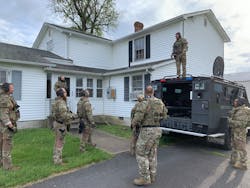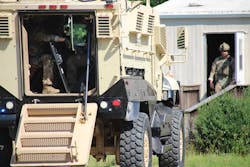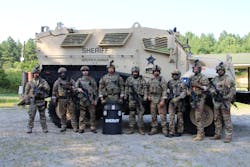SWAT Spotlight: Spotsylvania County Sheriff's Office
Three hundred years ago this year, Spotsylvania County was founded in the Commonwealth of Virginia. One year later, the Spotsylvania County Sheriffs Office was brought into being. Like probably every other sheriffs office in the country, it started out small and “part time.” There wasn’t anything like full time or part time back then. There was just the job you did as needed. That said, the Spotsylvania County Sheriffs Office (SCSO) grew and developed and in the late 1980s it formed its Special Weapons And Tactics (SWAT) team.
Serving a county that encompasses 414 square miles and has a population of roughly 140,000 citizens, the SCSO has a current authorized sworn strength of 217 full time personnel. They are supported by 70 support personnel and an additional 30 (authorized) part time deputies. During the interview, it was surprising to learn that a sheriffs office of this size and located not far from a large city (Spotsylvania County is about an hour south of Washington, D.C.) had part-time deputies. As one supervisor on the agency said, though, having the flexibility of some part time deputies is often a strength that easily answers the occasional scheduling or assignment challenge.It was further interesting to learn that even as the interview was conducted regarding the SWAT team, the entire Special Operations Division (SOD) had just been founded as a stand-alone command with the SCSO. In the fall of last year (so, roughly a year ago) the SCSO SOD was created by order of Sheriff Roger Harris, with authorization from the County Council and at the request/recommendation of members of the senior command staff.
The SCSO SOD encompasses quite a few specialized duty sections. In fact, the number of specialized duties SCSO has was impressive given its size. The only thing that makes it all even more impressive is that fact that there are no full time deputies assigned to SOD. Every deputy is a patrol deputy first and all specialized duties are additional. Those specialized assignments/duties with the SCSO SOD include:
- SWAT
- School Resource Officers
- Traffic Enforcement
- Drone
- K-9
- Dive Team
- Honor Guard
- Crisis Negotiation Team
- Bicycle Patrol Unit
- Civil Disturbance Unit
- Marine Patrol
- Search and Rescue
Their Dive Team has 11 members, all PADI (Professional Association of Dive Instructors) certified. That Dive Team works in conjunction with the Marine Patrol unit, which is now equipped with three boats. When asked why they needed the capability since they’re so far from the Atlantic coast or Chesapeake Bay, they pointed out that Lake Anna is partly in their jurisdiction and there are other bodies of water accounting for 13 square miles of area in the county. Dive Teams don’t ONLY work in the bay, ocean or rivers. Lakes, quarries, reservoirs and even pools can create a need for their services.
The Honor Guard is a 10-man team and responds to many formal events as well as representing the sheriffs office during Police Week and other memorial events. The last specific team we’ll address is the Search And Rescue team. The SCSO SAR team has an impressive 27 members, all of whom were required to complete a four-day course of instruction. Spotsylvania County boasts the only law enforcement certified SAR team recognized by the Virginia Search and Rescue Council. Again, it may seem odd to have such a focus so close to a large metropolitan area, but Spotsylvania County has a lot of open area as compared to its population and the vast acreage of woodlands would be easy for anyone to get lost in.
Now… to the SWAT Team. As mentioned, the team has an authorized strength of 18 members. Their strength at time of interview was 16. The team is “part time” and decentralized meaning the deputies assigned all have other duties that are their priority. Meeting all SWAT qualifications and answering SWAT calls is secondary to their first assignment.
To qualify for the SWAT team, a deputy must first have completed 18 months of independent patrol. That’s an important difference from 18 months out of the academy. “Independent patrol” means that they had been cut loose from Field Training (FTO) as well. So, after a year and a half of independent patrol, if they wish to join the SWAT team they have to submit a letter of intent/interest. That letter has to be accompanied by a biography and has to carry their immediate supervisor’s approval.If accepted to try out for the team, the applicant must pass a written test that is focused on special operations as compared to “routine” patrol. If they pass the written test they must also pass the agency’s standard fitness test, score 90% or better on the agency’s standard handgun qualification course and then pass the specifically designed SWAT fitness test. Along the way, in the process, there are at least two oral boards conducted and opportunities for the applicants to interact with the team members. Interestingly, the command staff is responsible for weeding out those applicants who don’t meet the minimum standards, but it’s the team members themselves who select which applicants get to join the team. If selected, the applicant still has to pass Basic SWAT School—a one-week course that Spotsylvania County teaches in-house. They also teach a one-week precision rifle (sniper) program and encourage SWAT team members to attend it. All SWAT team members must qualify with their firearms quarterly. The precision rifle course is out to 250 yards while the patrol rifle course is out to 50 yards and the handgun course is out to 25 yards.
The bulk of the SWAT Team’s work is high-risk warrant service and barricaded suspect calls. That said, they also train and coordinate with security at the nuclear power plant located nearby on Lake Anna as well as all of the park-focused agencies: the Department of Wildlife Resources, National and State Park services.
For land-based high-risk operation response (or for show at various events where it can help with community relations), the team is equipped with a Bearcat APC, an MRAP and a utility truck which is a box truck built on a 3500 pickup truck frame. SCSO also has a mobile command post that sees all of the normal uses—from emergency incident command and coordination to being the command center for special events or as a command and support hub for field training events.
The SWAT team makes it a goal to have all members cross-trained for all jobs, but discussion about tactical medical/trauma care revealed that they want to focus on increasing their skills in that area. While all of the team members have completed Advanced First-Aid (hasn’t every cop everywhere?) and most, if not all, of them have completed a Tactical Emergency Casualty Care (TECC) course, none of them are EMT certified. With the obvious high-threat nature potential of the duties they perform or respond to, they recognize the prudence of getting several team members EMT certified. Time is the biggest challenge as all of the team members already have primary duties and if they have to come off the street for a dedicated three-week program (available nearby), someone else has to cover their duties. Coordination of workload therefore is the biggest challenge. Still, the team command staff members recognize the need and have the desire to get at least two team members EMT certified. Ideally, it would be good for all team members to receive and achieve that certification, but realistically speaking, one EMT for every six-to-eight team members would be good. Given their team size, that means two or three EMTs.All in all, what the Special Operations Division accomplishes, given the manpower available, is impressive. And focusing even further on the SWAT Team, being decentralized and “part time,” the fact that they have so many capabilities is even more impressive. As time and budget permits, they will surely grow to increase their skill sets and, no doubt, someday be a full-time dedicated team.

Lt. Frank Borelli (ret), Editorial Director | Editorial Director
Lt. Frank Borelli is the Editorial Director for the Officer Media Group. Frank brings 20+ years of writing and editing experience in addition to 40 years of law enforcement operations, administration and training experience to the team.
Frank has had numerous books published which are available on Amazon.com, BarnesAndNoble.com, and other major retail outlets.
If you have any comments or questions, you can contact him via email at [email protected].







